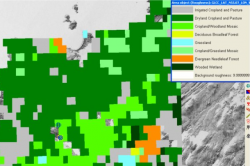Global Land Cover Characteristics: Difference between revisions
m (Morten moved page Global Land Cover Classification to Global Land Cover Characteristics) |
No edit summary |
||
| Line 1: | Line 1: | ||
[[Category:Online Data]][[Category:Digital Roughness Data]] | |||
== Introduction == | == Introduction == | ||
[[File: GLCCandWindPRO.png|right|thumb|250px|Global Land Cover Roughness Data in WindPRO]]Initially, the Global Land Cover Classification (GLCC) dataset was developed for land cover characterization in the range of environmental research and modelling applications. It is derived from the [http://en.wikipedia.org/wiki/Advanced_Very_High_Resolution_Radiometer Advanced Very High Resolution Radiometer (AVHRR)] data spanning a 12 month period from April 1992 to March 1993. The ACHHR is a space-borne sensor mounted on the National Oceanic and Atmospheric Administration (NOAA) family of polar orbiting platforms. | [[File: GLCCandWindPRO.png|right|thumb|250px|Global Land Cover Roughness Data in WindPRO]]Initially, the Global Land Cover Classification (GLCC) dataset was developed for land cover characterization in the range of environmental research and modelling applications. It is derived from the [http://en.wikipedia.org/wiki/Advanced_Very_High_Resolution_Radiometer Advanced Very High Resolution Radiometer (AVHRR)] data spanning a 12 month period from April 1992 to March 1993. The ACHHR is a space-borne sensor mounted on the National Oceanic and Atmospheric Administration (NOAA) family of polar orbiting platforms. | ||
Revision as of 17:25, 26 May 2013
Introduction

Initially, the Global Land Cover Classification (GLCC) dataset was developed for land cover characterization in the range of environmental research and modelling applications. It is derived from the Advanced Very High Resolution Radiometer (AVHRR) data spanning a 12 month period from April 1992 to March 1993. The ACHHR is a space-borne sensor mounted on the National Oceanic and Atmospheric Administration (NOAA) family of polar orbiting platforms.
Coverage
This dataset has a global coverage. It is based on a 1 km x 1 km grid, so note that such a resolution is to coarse for Micro scale AEP calculation models! This data is the version 2.0 of the global land cover characteristics data base, see the USGS web site.
Legends
Various legends exist for this dataset. At EMD, we use the legend from the US Geological Survey, see the table below. In addition to the legend, we (EMD) also suggested a roughness length, z0. This length is shown in the last column of the table.
| ID | Land Cover Type | EMD Roughness Class |
|---|---|---|
| 1 | Urban and Built-Up Land | z0=0.400 |
| 2 | Dryland Cropland and Pasture | z0=0.100 |
| 3 | Irrigated Cropland and Pasture | z0=0.100 |
| 4 | Mixed Dryland/Irrigated Cropland and Pasture | z0=0.100 |
| 5 | Cropland/Grassland Mosaic | z0=0.070 |
| 6 | Cropland/Woodland Mosaic | z0=0.150 |
| 7 | Grassland | z0=0.050 |
| 8 | Shrubland | z0=0.070 |
| 9 | Mixed Shrubland/Grassland | z0=0.060 |
| 10 | Savanna | z0=0.070 |
| 11 | Deciduous Broadleaf Forest | z0=0.400 |
| 12 | Deciduous Needleleaf Forest | z0=0.400 |
| 13 | Evergreen Broadleaf Forest | z0=0.500 |
| 14 | Evergreen Needleleaf Forest | z0=0.500 |
| 15 | Mixed Forest | z0=0.400 |
| 16 | Water Bodies | z0=0.0002 |
| 17 | Herbaceous Wetland | z0=0.030 |
| 18 | Wooded Wetland | z0=0.100 |
| 19 | Barren or Sparsely Vegetated | z0=0.020 |
| 20 | Herbaceous Tundra | z0=0.050 |
| 21 | Wooded Tundra | z0=0.150 |
| 22 | Mixed Tundra | z0=0.100 |
| 23 | Bare Ground Tundra | z0=0.030 |
| 24 | Snow or Ice | z0=0.001 |
License and Acknowledgement
This dataset is in the US Public Domain. USGS only asks that proper credit is given while using this dataset. A suggested format is to write:
Credit: U.S. Geological Survey.
External Link
Global Land Cover Characteristics Data Base Version 2.0, available at: http://edc2.usgs.gov/glcc/glcc.php (2013).